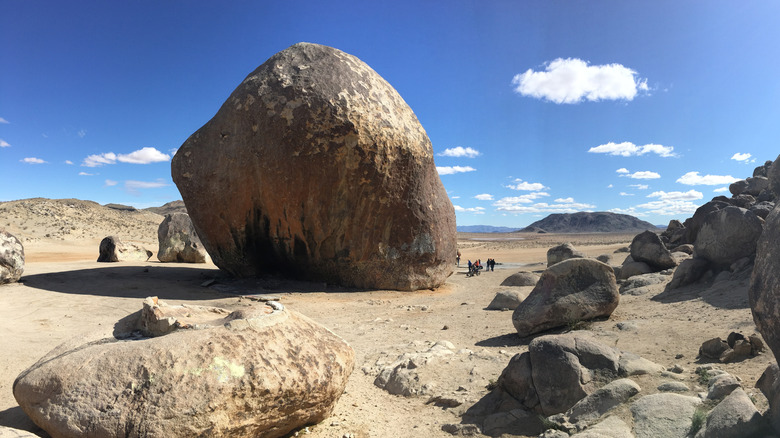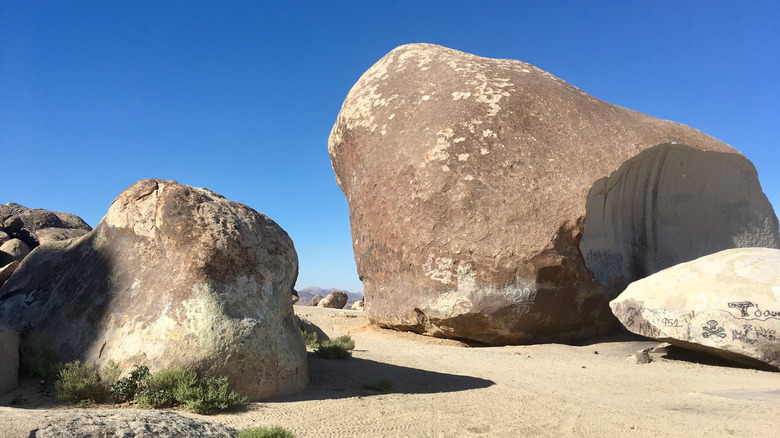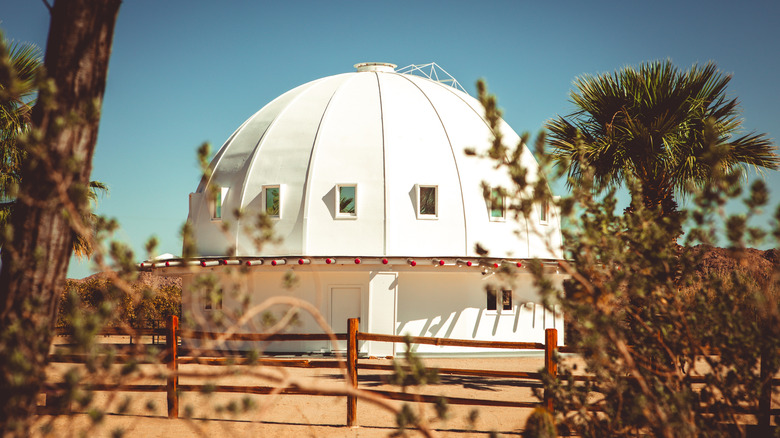Hidden In The California Desert Is A Giant Boulder Surrounded By Colorful UFO Legends And Lore
As the state with the most national parks, California is full of endless charm and many a wonder. In fact, one of its parks is in the vicinity of a legendary monolith whose sheer scale must be seen to be believed. The Giant Rock in Landers, 30 minutes north of the town of Joshua Tree, stands seven storeys tall and has earned a reputation for being the largest freestanding boulder in the world. It's said to weigh 30,000 tons and cover 5,800 square feet of dusty ground in an isolated corner of Southern California's Mojave Desert. A whole 3 miles beyond the outskirts of Landers, there's nothing else of interest in the vicinity — you'd have to drive out to the Rock just to see it. Luckily, its eccentric history and UFO lore are an excuse enough to make the detour.
Cropping out from the desert's vast nothingness, the Rock is an easily identifiable landmark, though no one really knows anything about how it was formed. For hundreds, if not thousands, of years before European settlement, the Serrano and Chemehuevi Native American desert tribes revered it as an Indian Holy Ground of important gatherings among chieftains. They marked its north face with an image of a scorpion to protect the surrounding area and signify that it was a special place. And of course, as an exceptional landmark, it has borne witness to a few exceptional people and moments in history, including a resident German miner, a WWII pilot turned meditation and extraterrestrial fanatic, and a historic prophecy about the future of humankind.
The strange histories of Giant Rock
The Giant Rock first came into interest for Westerners during the Great Depression, when a lone prospector and squatter named Frank Critzer decided to carve a home for himself in the ground beneath it using dynamite. His ingenious 400-square-foot home provided natural temperature control, thanks to its underground rock insulation. He lived in peace at Giant Rock for 12 years, until rumors spread during WWII of him being a German spy, resulting in a police raid during which he was bombed to death in his home.
Five years later, a wartime pilot and confidant of Critzer, George Van Tassel, took over the Giant Rock property, which consisted of an airstrip and roads built by Critzer. Van Tassel built a visitor's center and cafe, the Come On Inn, and held meditation circles in Critzer's underground room, during which he claimed to have been contacted by a being from Venus. Allegedly, the alien instructed him to build the Integratron — a 16-sided dome made entirely of wood that is supposed to serve as a time machine, an anti-aging device, and a portal to extraterrestrial communication. The legends stirred up by the six books Van Tassel published about his experience attracted an audience of 11,000 to his annual Giant Rock space convention in its heyday.
However, the property fell into disrepair following Van Tassel's death in 1978, and the facilities were demolished — only the Integratron remains as the keeper of their legacy. In 2000, following a ceremony conducted by a Los Angeles-based healer named Mataji, a large part of the Rock broke off and fell to the ground, revealing a white granite interior — a formidable sign spelling the possible prolongation of humankind. Amazingly, Hopi shamans had predicted such an incident as far back as the 1920s.
Visiting Giant Rock today and what to do nearby
To witness the Giant Rock, its fractured side, and the remains of Frank Critzer's underground home, you'll have to drive more than two hours east of central Los Angeles on Interstate 10 and local Highway 62, or just one hour north of Palm Springs. The road leading north from Landers is bumpy and unpaved, covered in desert sand, so it's recommended to travel in a 4WD or high-clearance vehicle. However, the landmark is essentially due north of the Integratron, which remains a relic of the space-craze culture that George Van Tassel invited to Landers. Today, it's an acoustic center offering sound baths using crystal singing bowls, gongs, and Native American instruments for $55 per person, as of the time of this publication.
If you're looking for other off-the-radar things to do in the area — aside from climbing and hiking among the unique rock formations and trees that populate Joshua Tree National Park — consider visiting Pioneertown, a quirky desert destination favored by filmmakers, just 20 miles down the road, on the way back to Joshua Tree. The town resembles a Wild West movie set from Hollywood and is home to Pappy & Harriet's Pioneertown Palace, a biker bar-turned-hipster-concert-hall that frequently features top-name acts. "J-Tree," as it's known in LA, is a popular out-of-town retreat for Los Angelenos, so the community has a host of stays if you wish to spend a night out in the desert. Options range from glamping and motels to expensive AirBnBs — though none is quite as fancy as the surreal Invisible House, an eco-luxe retreat where overnight bookings start at $1,700 per night.


